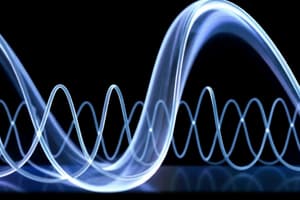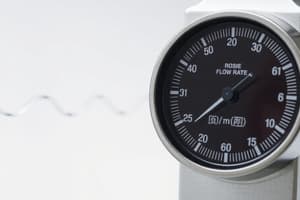Podcast
Questions and Answers
What are the two types of waves in regard to medium needs?
What are the two types of waves in regard to medium needs?
- Compression and Rarefaction waves
- Mechanical and Electromagnetic waves (correct)
- Amplitude and Frequency waves
- Longitudinal and Transverse waves
Ultrasound waves are classified as which type of wave?
Ultrasound waves are classified as which type of wave?
- Longitudinal mechanical waves (correct)
- Compression waves
- Electromagnetic waves
- Transverse waves
Which part of a transverse wave represents the highest points?
Which part of a transverse wave represents the highest points?
- Wavelength
- Crests (correct)
- Troughs
- Compression
How is energy storage different between a capacitor and inductive coil in an LC oscillator?
How is energy storage different between a capacitor and inductive coil in an LC oscillator?
What is Coulomb's law in electricity?
What is Coulomb's law in electricity?
Electric charge is quantized.
Electric charge is quantized.
What does the Reverse Piezoelectric Effect refer to?
What does the Reverse Piezoelectric Effect refer to?
For resistance and resistivity of a material, resistance is directly proportional to _________.
For resistance and resistivity of a material, resistance is directly proportional to _________.
Match the following terms with their definitions:
Match the following terms with their definitions:
Flashcards are hidden until you start studying
Study Notes
Waves and Oscillations
- There are two types of waves: mechanical waves (require a medium to propagate) and electromagnetic waves (do not require a medium to propagate).
- Ultrasound waves are classified as longitudinal mechanical waves.
- In a transverse wave, the crests represent the highest points.
- Frequency is defined as the number of waves produced in a unit time.
LC Oscillators
- The main components of an LC oscillator are an inductive coil and a capacitor.
- In an LC oscillator, energy is stored differently in the capacitor and inductive coil: capacitor stores energy in an electric field, while the inductive coil stores energy in a magnetic field.
- The quality or Q-factor of the circuit determines the amount of damping in an LC circuit.
- In a LC tank circuit, resonance occurs when capacitive and inductive reactance are equal.
Magnetostriction Ultrasonic Generators
- The strength of the magnetic field affects the change in length of a ferromagnetic rod in a magnetostriction ultrasonic generator.
- Resonance is achieved in a magnetostriction ultrasonic generator by matching the frequency of the vibrating rod with the circuit frequency.
- An advantage of a magnetostriction ultrasonic generator is that it is easily available and inexpensive.
Piezoelectric Ultrasonic Generators
- A piezoelectric crystal produces an alternating potential difference while receiving ultrasound.
- Using a quartz crystal makes a piezoelectric oscillator more efficient by increasing stability in frequency.
Therapeutic Ultrasound
- The general range for therapeutic ultrasound intensity levels is 0.1-3.0 W/cm2.
- When the ultrasound amplitude is doubled, the energy delivered to the patient is quadrupled.
- The Doppler effect is primarily related to frequency and pitch in sound waves.
- Increasing the relative intensity by 3dB corresponds to a doubling of the absolute intensity.
- The Fraunhofer zone is characterized by a regular sonic field due to insignificant path length differences.
- The unit of power for ultrasound beams is Joule/second.
- Therapeutic shock waves are distinct from ultrasound in terms of wave behavior, with shock waves being more intense and faster.
Electric Charge and Electric Field
- Electric charge is quantized, meaning it comes in discrete packets.
- Coulomb's law states that the force between two charges is directly proportional to the product of the charges and inversely proportional to the square of the separation between the charges.
- The electric field at a point is the amount of electric force acting on a positive test charge at that point.
- Electric flux is the measure of electric field lines penetrating normally on unit area of this surface.
Circuits and Resistance
- The unit of potential difference in a circuit is Volt.
- The frequency of a wave with a periodic time of 0.02 seconds is 50 Hz.
- The Peak-to-peak value measures the difference between the lowest negative amplitude and the highest positive amplitude on both sides.
- The Root-Mean-Square (RMS) value is used to relate the amount of AC to DC values for the heating effect.
- According to Ohm's Law, voltage (V), current (I), and resistance (R) are related by V=IxR.
Capacitors
- The unit of capacitance for a capacitor is Farads.
- Coulombic repulsion limits the addition of more charge on the plates of a capacitor.
- In the charging process of a capacitor, when the initial amount of charge on a capacitor is small, the voltage across the capacitor increases rapidly.
- When more charge is stored on the plates of a capacitor, the voltage across the capacitor increases more slowly.
- The equation Q = CV represents the charge stored on the plates of a capacitor.
- Increasing the surface area of plates increases the capacitance of a capacitor.
Direct Current (DC) and Alternating Current (AC)
- Direct Current (DC) is characterized by a continuous unidirectional flow of charged particles.
- Alternating Current (AC) is characterized by an intermittent (variable) bidirectional flow of charged particles.
Materials Properties
- Resilience is the ability of a material to absorb energy up to the proportional limit.
- Yield strength is a measure of a material's resistance to plastic deformation.
- Toughness is the ability of a material to absorb energy up to the fracture.
- Fatigue occurs when a material is subjected to dynamic load.
- Malleability is the ability of a material to undergo permanent compressive deformation without fracture.
- Ductility is the ability of a material to undergo permanent tensile deformation without fracture.
- Elastic modulus represents the rigidity of materials.
Mechanics
- The main difference between statics and dynamics in mechanics is that statics involves objects at rest or moving without acceleration, while dynamics involves objects in motion with acceleration.
- Kinetics is the analysis of forces causing motion.
- Kinematics is the description of the motion.
Levers
- In a first-class lever, the fulcrum is placed between the resistance and the force.
- In a second-class lever, the resistance is placed between the fulcrum and the force.
- In a third-class lever, the force is placed between the fulcrum and the resistance.
- The location of a lever's axis improves its mechanical advantage by moving the axis closer to the resistance.
Studying That Suits You
Use AI to generate personalized quizzes and flashcards to suit your learning preferences.




